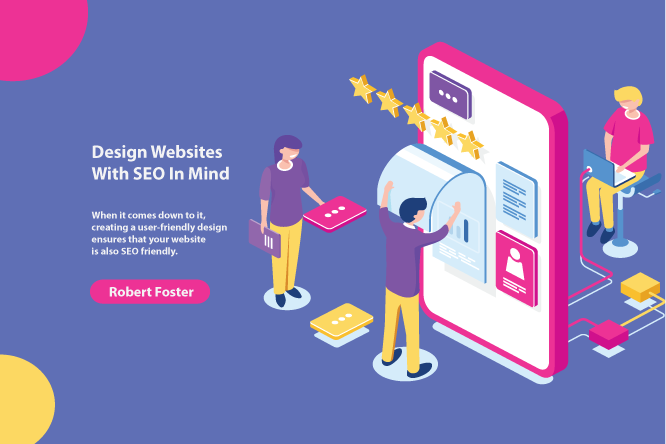Designing a Website That Search Engines (and Users) Love
Organic traffic is the name of the game when it comes to building an online presence. But, the question of the day is, “How do you get more organic traffic to your site?” It all starts with designing a website that Google loves. Sometimes business owners don’t make search engine optimization a priority when they’re creating their sites, and that’s a huge mistake.
Did you know that Google alone completes as many as 3.5 billion searches in one day? That gives you a lot of chances to connect with your ideal customer. Unfortunately, they can’t find you if you’re not implementing smart SEO tactics in the design of your site.
It doesn’t matter how beautiful or professional your website looks, if it’s not designed to be search engine friendly, you’re going to miss out on that crucial organic traffic. Google has an astounding 200 ranking factors in their algorithm, and they change them all the time, so incorporating SEO right from day one is essential.
Let’s take a look at the ways search engine optimization should be part of your design process. These things will not only help with SEO but also with lead generation and conversions over time. Ensuring that your website is user-friendly is also crucial on all fronts.
Why It’s Crucial To Design a Website With SEO In Mind
TOP 5 Reasons

Are keywords the first thing you think about when it comes to SEO? Sure, Google loves fresh, up to date content that’s relevant and keyword-rich, and websites with a good content strategy will rank higher on SERPs (Search Engine Results Pages).
#1 – User-Friendly Design is Essential for SEO
Your bounce rate and dwell times affect the way search engines like Google rank your pages. You also want your website visitors to hang out for a while, looking at your products and services and viewing your content to increase leads and conversions.
Websites that are attractive, user-friendly, and have clear navigation and calls to action have longer dwell times and lower bounce rates. Needless to say, providing a good user experience (UX) is vital.
Here are some design elements that factor into a good UX:
- The overall design should be simple. Keep it clean, using visual elements that support your conversion efforts without distracting from them. Leave some whitespace on your pages, so your visitors don’t get overwhelmed and click away.
- Navigation should be concise, clear, and straightforward. Make it easy for visitors to browse your site by keeping navigation menus simple. Include prominent labels with clear descriptions on your menu tabs, directing users to where you want them to go next.
- Your content should be scannable and easy to digest. The number of visitors browsing the internet on a mobile device increases every day. Mobile users are much more likely to scan the page and pick out important points that relate to them than are to read the entire page word for word. Always break your content up into short, digestible paragraphs and include descriptive headers to make the page easy to scan.
- Don’t include a lot of barriers on your pages. In other words, don’t expect visitors to sign up for your newsletter or fill out some other form the moment they land on your page. That creates a bad user experience for first-time users who haven’t had a chance to get to know you yet. Only ask them to fill out forms when it’s really necessary and be sure to keep them short and sweet.
#2 – Have a Clear Message that Users and Search Engines Can Understand
Don’t make your website visitors and search engines have to work to figure out what your website is all about. Be clear about your message to boost SEO and improve the user experience. No matter what industry you’re in, spell your message out in clear, concise terms that search engine crawlers can understand.
If your company specializes in website design, say so in clear, simple terms in your opening paragraph. Sure, you’ll want to include your USPs further down the page, but clearly stating your message at the beginning is vital.
Searches in one day
Ranking Factors
#3 – Google Looks for Quality Content and Visual Media When Ranking Your Page for SEO
Quality content is an essential part of the user experience, and it’s necessary for search engines, but including compelling visual media will help with both, too. Just be careful not to include so much media that it becomes distracting or overwhelming for your user.
If your site has lots of visual media but not many relevant words, Google will decide your content doesn’t have value, and I’m sure you can guess that’s not good for SEO. It’s ok to feature several images, videos, or infographics on a page, just be sure to also include written summaries of the videos or infographics and balance everything out with plenty of related content. Search engines need words to be able to understand what your page is all about.
Be sure to optimize your images as well. Use a plug-in to compress images, so they load quickly and include relevant keywords in the alt tags. Google even looks for keywords in Flash, so don’t forget to include them there as well.
#4 – Optimized Header Tags are an Important Design Element for SEO
We’ve already discussed how to use header tags to make your content scannable, but don’t forget that they’re also essential for SEO. Incorporate keywords into every heading if possible, but make sure they sound natural. Google considers your headers by hierarchy, so the keywords in your H1 tag are most important, followed by H2s and so on.
#5 – Mobile-Friendly Design is a Must
As mentioned, most of your visitors will be on a mobile device. It’s only natural that Google looks for websites that are designed for mobile users. Design your site so that it’s responsive for phones and tablets if you want to rank at the top of SERPs.
Conclusion
When it comes down to it, creating a user-friendly design ensures that your website is also SEO friendly. Pairing these savvy design strategies with high-quality, useful content ensures that you have a website that search engines and users love.

Robert Foster
Web Dev, Writer
Robert is a 30 years old web dev, nature survivalist and a somewhat prolific writer. He spends most of his free time outdoors and if you can’t find him for a couple of days, he’s probably somewhere on a biking, cycling or hiking holiday again.
















0 Comments